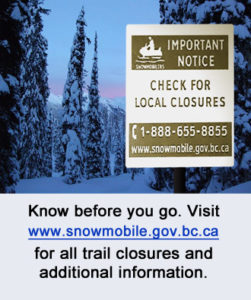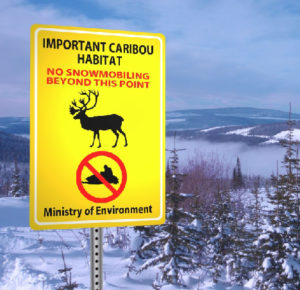Mountain Caribou
It is your responsibility to know and obey all Wildlife Closures.
For the Caribou, the winter months are the most critical time of the year. If you see a caribou while riding:
- Do not approach, pursue or otherwise harass them
- Move at least one kilometer away
- Warn others in your area that Caribou are near
- Report any sighting to info@sledblueriver.com please include locations, numbers of animals, and their actions (ex sleeping, resting or moving and in what direction)
- This info is important for all riding areas.
These snowmobiling areas are being monitored for caribou use and conflicts with snowmobiling. Compliance with the closed area boundaries and avoiding Caribou when they are in the area will minimize conflicts and keep these snowmobiling opportunities open for all to enjoy.


The Ground Hog herd and North Blue Herd is a part of a population of mountain caribou that have declined dramatically over the past decade.
In response to the decline and the Federal Species at Risk Act, the provincial government is working on implementing a Mountain Caribou Recovery Plan for BC. These areas are an important wintering habitat for the mountain caribou. It is the riders responsibility to know where they are in relation to the boundaries at all times.
If you are in an area that has closures it is your responsibility to know where the boundaries are all always stay within them. Even small infractions can have a drastic impact!
We need cooperation with this or we will lose access to these areas.
For all caribou closures http://www.env.gov.bc.ca/fw/wildlife/snowmobile-closures/ or email BRPPS at info@sledblueriver.com or phone 1-888-655-8855 for further back country closure information.
For a complete list of closures and extra information www.snowmobile.gov.bc.ca
If you’ve been riding in Blue River, BC, you know what it’s like: fresh powder, wide open spaces and challenging terrain.
You may have been fortunate enough to see mountain caribou. The Ground Hog herd is a part of a population of mountain caribou that have declined dramatically over the past decade. In response to the decline and the Federal Species at Risk Act, the provincial government is working on implementing a Mountain Caribou Recovery Plan for BC. The big question right now for government and snowmobilers is can we keep the riding opportunities open while recovering the mountain caribou population? The reasons for the caribou decline are complex and likely a result of numerous direct and indirect human impacts on the land base. The Ground Hog area is important wintering habitat for the mountain caribou.
Mountain caribou depend upon large tracts of old-growth forest in the Interior Wet Belt. Over the past century, old forests in this high snowfall zone of southeastern British Columbia have become far less abundant. Habitat has been lost to fires, timber harvesting, hydroelectric reservoirs and human settlement. In many places, the remaining habitat occurs in small patches. The loss and fragmentation of old-growth forests may cause caribou to abandon some areas and it also increases the risk that the caribou will be killed by predators, poachers, or distributed by outdoor recreationists. Resource management and recreation area guidelines have been developed for all herds of mountain caribou in British Columbia, and most herds are currently monitored.


Over the last several years the Blue River Powder Packers, government agencies and various industries have been working on ways to reduce the risks to the caribou and recover the populations in the Blue River area. There are now a set of designated open riding areas and legal closures. These closure boundaries are most often between open alpine and the sub-alpine forested areas. We believe that if riders stay on the designated trails, stay within the boundaries and make it common practice to stay away from caribou, the risk to mountain caribou will be significantly reduced and we will be on our way to the recovery goal.
Compliance with closures is key and you will notice increased signage and a record and report program for riders to report animal sightings and other notable information as well as continued enforcement from the Conservation Service.
Over the next few years we should be able to judge whether this management approach is working or not. With a little effort we can meet the recovery goal and keep the riding opportunities open for all the enjoy.
